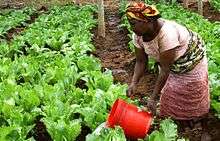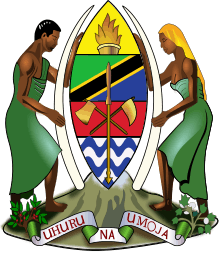Agriculture in Tanzania

Agriculture is the main part of Tanzania's economy.[1] As of 2016, Tanzania had over 44 million hectares of arable land with only 33 percent of this amount in cultivation. Almost 70 percent of the poor population live in rural areas,[2] and almost all of them are involved in the farming sector.[3] Land is a vital asset in ensuring food security, and among the nine main food crops in Tanzania are maize, sorghum, millet, rice, wheat, beans, cassava, potatoes, and bananas. The Agricultural industry makes a large contribution to the country's foreign exchange earnings, with more than US$1 billion in earnings from cash crop exports.[4]
The 7 main cash crops are as follows;[5]
- Coffee
- Sisal
- Cashew nuts
- Tea
- Cotton
- Tobbacco
At one point in its Agriculture industry history, Tanzania was the largest producer of sisal in the world.[6]
The agriculture sector faces various challenges and had been the governments top priority to develop to reduce poverty and increase productivity.[7] Farming efficiently has been a challenge for many farmers, and lack of finances and farming education has caused many to remain subsistence farmers. Farm sizes remain very small with an average plot size being around 2.5 ha.[8]
Challenges on the Agriculture Industry of Tanzania include lack of agricultural technology, droughts, floods, and agriculture temperature shocks. These pose severe challenges to the living standards of most of people involved in the Agriculture Industry in Tanzania and create huge increases in unemployment, hunger, malnutrition and starvation, and diseases rates.
Large declines in commodity prices, decreased export revenues, increased trade and budget deficits all amount to hindering the growth of the country's gross domestic product (GDP). The Agriculture Industry in Tanzania represents 32.4 percent of GDP of Tanzania.[9]
Soil and topography
Tanzania has an area of 945,000 square kilometres (365,000 sq mi) with inland lakes covering 6 percent of that (59,000 square kilometres (23,000 sq mi)). The Great Rift Valley runs north to south and contains most of the country's lakes. The country is home to the highest point in Africa, Mount Kilimanjaro, and the lowest point in the continent, Lake Tanganyika.[10]
Soil types vary drastically throughout the country. There are six main types of soil types in the country as follows;[11]
- Volcanic soils: predominantly in the northern highland regions.
- Sandy soils: predominantly in the coastal regions and used mainly for grazing.
- Granite/Gneiss soil: predominantly in the northern regions of Mwanza and Tabora.
- Red soils: predominantly in the central plateau, including the Dodoma Region.
- Ironstone soils: predominantly in the western regions like Kagera and Kigoma.
- Vertisol: called mbuga black soil, spread across most of the country.
In summary for the variety of soil types studies still do not indicate which typo of soil suit best for farming of a cash crop or a food crop.
Cash crops

Coffee production
Coffee is grown on a large scale on both estates and by smallholders that form co-operatives and involves over 400,000 farmers. Coffee has been grown in the country since the colonial times and is a major export crop, earning over 17 percent of the country's foreign exchange. Tanzania mainly grows the arabica type; however, small farms in the Kagera Region grow Robusta coffee. Tanzanian coffee is globally more commonly known as Kilimanjaro Coffee.[12]
Sisal production

Sisal was brought to Tanzania from Mexico by the German East Africa Company in the late 19th century. Sisal is grown in the northern regions of the country, such as Tanga and Kilimanjaro. At the time of independence in 1961, Tanzania was the largest producer of sisal in the world. Sisal production continued to decline after the Ujamaa movement and the continued depreciation of world prices. In recent years, the government has tried to liberalize the sector to encourage growth and increase export revenues.[13]
Cashew production
Cashew production in Tanzania began towards the end of the British trusteeship of Tanganyika in the 1950s. In 2012, Tanzania was the world's eighth largest producer of cashews and the fourth largest in Africa.[14] Poor regulation and lack of reliable payments to farmers has plagued production. Cashew mainly grows in the southern regions of the country such as Mtwara and Lindi, and more than 90 percent of the nuts are exported in raw form. The raw nuts are mainly exported to India for processing due to a very small processing capacity domestically. The lack of domestic processing firms has cost the country vital foreign revenue and thousands of jobs. The Government has been struggling to find potential investors to revive the cashew processing industry.[15]
Food Crops
The 8 main food crops grown in Tanzania at the moment are;
Fruits in Tanzania
Fruits in Tanzania include bananas.
Statistics
Main crop production


The ten non-cash crop production from 2013 as reported by the Food and Agriculture Organization of the United Nations as below table:[16]
| Number | Food Crop | Area Harvested | Yield Hg/Ha | Production, 1000 tonnes |
|---|---|---|---|---|
| 1 | Casava | 950,000 | 56,842 | 5,400 |
| 2 | Maize | 4,000,000 | 11,750 | 4,700 |
| 3 | Sweet Potatoes | 675,000 | 45,926 | 3,100 |
| 4 | Sugar Cane | 30,000 | 1,000,000 | 3,000 |
| 5 | Rice, Paddy | 900,000 | 20,889 | 1,880 |
| 6 | Potatoes | 175,000 | 74,286 | 1,300 |
| 7 | Beans, dry | 1,300,000 | 8,846 | 1,150 |
| 8 | Sunflower seed | 810,000 | 13,370 | 1,083 |
| 9 | Sorghum | 900,000 | 9,444 | 850 |
| 10 | Groundnuts, with shell | 740,000 | 10,608 | 785 |
| Source: FAO | ||||
See also
References
- ↑ "New Agriculturist: Country profile - Tanzania". www.new-ag.info. Retrieved 7 February 2016.
- ↑ "Rural population (% of total population) | Data". data.worldbank.org. Retrieved 2017-10-31.
- ↑ "Tanzania Agriculture". www.tanzaniainvest.com. Retrieved 11 March 2016.
- ↑ "OEC - Tanzania (TZA) Exports, Imports, and Trade Partners". atlas.media.mit.edu. Retrieved 11 March 2016.
- ↑ "TANZANIA COFFEE INDUSTRY PROFILE". Tanzania Coffee Board. Tanzania Coffee Board. 2010. Retrieved 28 December 2015.
- ↑ "Tanzania Agriculture, Information about Agriculture in Tanzania". www.nationsencyclopedia.com. Retrieved 11 March 2016.
- ↑ "Reducing poverty through Kilimo Kwanza" (PDF).
- ↑ Gaddis, Isis. "Land of opportunity: Should Tanzania encourage more large-scale farming?". blogs.worldbank.org. Retrieved 11 March 2016.
- ↑ "Tanzania. Poverty Report" (PDF).
- ↑ "Tanzania". www.infoplease.com. Retrieved 11 March 2016.
- ↑ "Tanzania". www.fao.org. Retrieved 11 March 2016.
- ↑ "Tanzania's Coffee Sector: Constraints and Challenges in a Global Environment" (PDF). World Bank. June 2003. Retrieved 7 February 2016.
- ↑ "Sisal: The most useful plant you've never heard of". CNN. Retrieved 14 February 2016.
- ↑ "Tanzania: Going nuts over cashew". African Business Magazine. Retrieved 14 February 2016.
- ↑ "Tanzania's Cashew Sector: Constraints and Challenges in a Global Environment" (PDF). World Bank. June 2004. Retrieved 2 February 2016.
- ↑ "Tanzania Cereals Production - Open Data for Tanzania". tanzania.opendataforafrica.org. Retrieved 11 March 2016.
